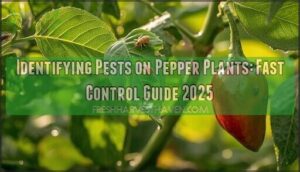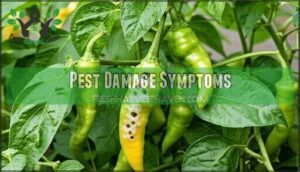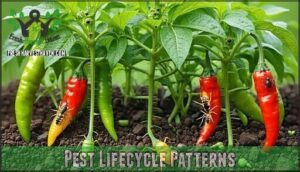This site is supported by our readers. We may earn a commission, at no cost to you, if you purchase through links.

Check leaf undersides for aphid clusters that leave sticky honeydew, creating a mess that attracts ants and sooty mold.
Look for irregular holes from armyworms, shothole patterns from flea beetles, or tunnels in stems from European corn borers.
Wilting leaves often signal spider mites or root damage, while fruit punctures indicate pepper weevils or maggots working inside.
Timing matters too – cutworms strike at night, severing stems at soil level, while other pests follow predictable seasonal patterns.
Early detection turns a potential disaster into a manageable problem, emphasizing the importance of early detection.
Table Of Contents
- Key Takeaways
- Common Pepper Pests
- Pest Damage Symptoms
- Pest Lifecycle Patterns
- Pest Control Methods
- Preventative Measures
- Frequently Asked Questions (FAQs)
- Can I spray vinegar on my pepper plants?
- What are the pests of pepper plants?
- What’s eating holes in my pepper plant leaves?
- Can you spray vinegar on pepper plants for bugs?
- How do beneficial insects help pepper plants?
- When should I harvest damaged peppers?
- Can pests overwinter in greenhouse environments?
- What attracts pests to pepper plants initially?
- How do weather conditions affect infestations?
- How do weather conditions affect pepper pest populations?
- Conclusion
Key Takeaways
- Check leaf undersides weekly for aphid clusters and sticky honeydew – these tiny pests multiply rapidly and can double their population every few days
- Look for distinctive damage patterns like shothole feeding from flea beetles, irregular leaf holes from armyworms, and stem tunnels from corn borers to identify specific pests
- Monitor your plants at night since cutworms sever stems at soil level after dark, while many other pests follow predictable seasonal activity patterns
- Inspect fruits regularly for puncture wounds from pepper weevils and maggots – early detection prevents these pests from completing their lifecycle and spreading to healthy peppers
Common Pepper Pests
You’ll find several troublesome insects targeting your pepper plants, from tiny aphids clustering on stems to armyworms that can strip leaves overnight.
Knowing these common culprits—like European corn borers, cucumber beetles, flea beetles, and pepper maggots—helps you catch problems early and take action before your harvest suffers.
Aphids and Armyworms
Beneath your pepper plants’ vibrant foliage, two major culprits lurk: aphids and armyworms.
These pepper plant insects create distinct damage patterns you’ll need to recognize quickly.
Here’s how to spot each pest:
- Aphids – Tiny green clusters on stems and leaf undersides, leaving sticky aphid honeydew that attracts sooty mold
- Armyworms – Striped larvae creating irregular holes in leaves, moving rapidly between plants at night
- Damage timing – Aphids peak in warm, humid conditions while armyworm damage intensifies during summer heat
Control timing matters because aphid populations double every two days, while armyworms can strip plants in 48 hours.
Natural predators like ladybugs tackle aphids effectively, but armyworm damage requires faster intervention.
Understanding these lifecycle differences helps you choose the right approach – whether introducing beneficial insects or applying targeted treatments before populations explode.
European Corn Borers
European Corn Borers aren’t just corn pests—they’re pepper plant troublemakers too.
These destructive insects attack peppers across North America, with larvae boring into stems and fruits.
You’ll spot borer damage as entry holes and tunnels that weaken plants and invite rot.
The corn borers create perfect doorways for disease, making early pest identification critical for your pepper harvest success.
Cucumber Beetles
Cucumber beetles are spotted yellow-green invaders that’ll munch your pepper plants into Swiss cheese.
These 6-8mm pests create irregular feeding holes while spreading bacterial wilt disease – a double threat.
Adults emerge when temperatures hit 80°F, completing up to three generations per season.
Their whitish larvae attack roots underground.
Floating row covers provide 80% protection during vulnerable seedling stages, while neem oil offers solid control against adult populations.
Recognizing pest damage patterns is essential for early intervention and understanding the impact of these pests.
Flea Beetles
Small but mighty, flea beetles create distinctive shothole patterns on pepper leaves, weakening your plants.
These tiny jumping pests from the Chrysomelidae family damage foliage while their larvae attack roots underground.
These underground root raiders pack double trouble—chomping leaves above while their sneaky babies feast below
These tiny terrors pack a powerful punch, turning pepper leaves into confetti while their sneaky larvae wreak havoc below ground.
You’ll spot Flea Beetle Damage as small circular holes throughout leaves.
Combat them using floating Row Covers during vulnerable growth stages, or apply Spinosad Treatment and Pyrethrin Use for active infestations.
Companion Plants like radishes and marigolds naturally deter these pepper plant pests.
Pepper Maggots
Unlike flea beetles that create shotholes in leaves, pepper maggots (Zonosemata electa) target your fruit directly.
These small flies lay eggs inside developing peppers, creating white, legless maggots that tunnel through the flesh.
You’ll spot soft, sunken areas on fruits with visible exit holes where mature maggots emerge.
Preventative trapping using sticky traps helps monitor adult fly activity during peak midsummer season.
Natural predators offer limited control, making post-harvest removal of infested fruit essential for breaking the maggot lifecycle.
Pest Damage Symptoms
You’ll notice pest damage on your pepper plants through several telltale signs that help pinpoint exactly which unwelcome visitors have moved in.
Learning to recognize these symptoms quickly means you can act fast before minor issues become major headaches that could wipe out your entire crop, which is a key factor in maintaining a healthy harvest and avoiding complete loss.
Leaf Curling and Wilting
When you spot leaf curling and wilting on your pepper plants, you’re likely dealing with Aphid-Induced Wilting or spider mites sucking plant juices.
These tiny culprits cause pepper leaf damage by disrupting water flow and nutrient uptake. Aphids cluster on leaf undersides, while thrips create silvery stippling.
Mite Infestation appears as fine webbing and bronzed leaves. Don’t confuse pest damage with Watering Issues or Nutrient Deficiency – identifying pepper insects correctly saves time and your harvest.
Honeydew Buildup and Sooty Mold
Looking at your pepper plants, you’ll spot sticky, glistening drops on leaves – that’s honeydew from aphids and whiteflies feeding on plant sap.
This sugary substance attracts ants and creates a perfect breeding ground for sooty mold. The black, powdery fungal growth reduces photosynthesis by up to 40%, weakening your plants substantially.
Regular cleaning methods like water sprays help remove fresh honeydew buildup before mold takes hold. You can also apply neem oil treatments for organic pest control.
Fruit Damage and Drop
You’ll notice pepper fruit damage when corn earworms tunnel through ripening peppers, leaving visible holes and dark excrement trails.
Pepper weevils create smaller puncture wounds in developing fruits, while pepper maggots cause internal rot that leads to premature dropping.
These weevil tunnels and maggot infestation sites become disease entry points, allowing bacteria and fungi to spread rapidly throughout your harvest.
Stem and Root Damage
When cutworms attack plant stems at night, they’re basically giving your peppers a surprise haircut at ground level.
These sneaky larvae hide in soil during the day, then emerge to chew through stems like tiny lumberjacks.
Here’s what to watch for:
- Cutworm damage – stems severed cleanly at soil line
- Weevil tunnels – small holes boring into stems and buds
- Root rot – blackened, mushy root systems from excess moisture
- Stunted growth – plants that stop developing properly
- Nematode damage – swollen, knotted roots indicating microscopic worm activity
Install cutworm collars around young plants and consider nematode control for root protection.
Pest Lifecycle Patterns
Understanding the timing and lifecycle patterns of pepper plant pests gives you the upper hand in stopping damage before it spirals out of control.
You’ll catch early warning signs and know exactly when to deploy your countermeasures for maximum effectiveness, which is crucial for maintaining healthy plants and preventing pest-related issues, making effective management a key factor.
Armyworm Life Cycle
Understanding armyworm development helps you time interventions perfectly.
Female moths begin Egg Laying on leaf undersides, depositing 100-200 eggs that hatch within 2-5 days.
Larval Stages span six instars over 14-21 days—this destructive phase devours foliage rapidly.
Pupation Period occurs underground for 7-14 days before Adult Moths emerge.
Seasonal Activity peaks in late spring, completing multiple generations annually.
Target larvae with Bacillus thuringiensis during early instars.
Corn Earworm Habits
Unlike armyworms that follow predictable cycles, corn earworms march to their own beat.
These pepper pests stay active year-round in warmer regions, making pest identification tricky for gardeners.
Their rough, microspine-covered bodies distinguish them from smoother armyworms during insect identification.
You’ll spot their larvae tunneling into pepper fruits, creating entry points for rot and disease.
Their unpredictable seasonal activity means constant vigilance on your pepper plants.
Cutworm Behavior
These sneaky pests play hide-and-seek like pros.
Armyworms turn pepper gardens into midnight buffets while you sleep
During daylight hours, you’ll find cutworm behavior involves hiding in soil habitat beneath your pepper plants.
Once darkness falls, their nocturnal feeding kicks into high gear.
The larval stages emerge for their destructive stem cutting missions, slicing through your pepper stems at ground level like tiny lumberjacks.
Adult moth activity focuses on egg-laying, continuing this cycle of plant damage through strategic insect identification and pest identification.
Aphid Reproduction
Aphids multiply like there’s no tomorrow on your pepper plants, creating massive colonies through asexual reproduction.
These pepper pests can double their population every 1-2 weeks, with females producing up to 80 offspring without mating.
- Aphid Lifespan: Short but productive – females reproduce within days of birth
- Population Growth: Exponential expansion with up to 15 generations per season
- Winged Aphids: Develop when colonies get overcrowded, spreading to new plants
- Environmental Factors: Warm temperatures (68-82°F) and high humidity boost reproduction rates
This rapid reproduction makes early pest identification essential in your pest control strategy.
When aphid colonies reach critical mass, they trigger winged forms that’ll colonize fresh pepper plants.
Understanding these insect infestations helps you time interventions before populations explode.
You can also manage them by encouraging natural aphid predators.
Garden pests like aphids thrive on stressed plants, so maintaining healthy peppers reduces their reproductive success.
Pest Control Methods
Once you’ve spotted the troublemakers munching on your pepper plants, you’ll need a solid game plan to send them packing.
Your control arsenal ranges from gentle organic sprays to targeted biological warfare using beneficial bugs and nematodes.
Organic Pest Control
Focusing on natural solutions, you’ll find organic pest control offers safer alternatives for your pepper garden.
Natural predators like ladybugs demolish aphid colonies with impressive efficiency. These beneficial insects work around the clock, making pest identification easier by keeping populations manageable.
| Treatment | Target Pests | Application Rate |
|---|---|---|
| Neem oil | Aphids, mites, thrips | Weekly spray, 85% effective |
| Insecticidal soap | Soft-bodied insects | Every 3-5 days as needed |
| Diatomaceous earth | Beetles, crawling pests | Dust around plant base |
Companion plants like basil and marigolds create natural barriers against pepper pests. They’re like having security guards stationed throughout your garden.
Insecticidal soap disrupts pest cell membranes on contact, while diatomaceous earth works like tiny glass shards against crawling invaders. Many gardeners find neem oil applications highly effective.
This organic gardening approach takes patience but delivers lasting results. Your natural pest solutions won’t harm beneficial insects, keeping your garden’s ecosystem balanced. Regular applications during peak pest seasons guarantee maximum effectiveness without chemical residues on your harvest.
Chemical Pest Management
When organic methods aren’t cutting it, chemical pesticides pack more punch against stubborn pests. However, pesticide resistance is spreading fast—some armyworm populations show 50% reduced sensitivity to pyrethroids.
Smart dosage calculation and targeted application prevent waste while maintaining effectiveness.
Here’s your chemical arsenal:
- Pyrethroid insecticides (lambda-cyhalothrin) for armyworms and aphids—80% efficacy when timed right
- Neonicotinoid systemic insecticides (imidacloprid) for aphids and flea beetles—70% population reduction
- Carbamates and organophosphates for cucumber beetles—apply every 10-14 days during pressure
- Tank mixing two different chemical classes delays resistance by 18 months
- Nighttime applications reduce pollinator exposure by 40% while improving coverage
Always rotate synthetic chemicals annually to slow resistance buildup. Consider purchasing insecticides online for convenience.
Chemical safety means following pre-harvest intervals strictly—typically 7-21 days for pepper insecticides. Threshold-based spraying cuts total chemical use by 30% compared to calendar applications, saving money while protecting beneficial insects.
Beneficial Nematodes
Since beneficial nematodes target soil-dwelling pepper pests like cutworms and flea beetle larvae, they’re your underground army for pest control.
These microscopic warriors hunt down pest larvae in soil, releasing bacteria that eliminate threats within 48 hours.
For ideal nematode application, keep soil moist at 60-85°F and apply at dusk to protect nematode viability.
They won’t harm your peppers or beneficial insects—just the troublemakers hiding in your soil, which makes them a very effective and safe method.
Biological Controls
While beneficial nematodes work below ground, predatory insects tackle pests above the surface.
Ladybugs devour aphids like tiny vacuum cleaners, while lacewings hunt soft-bodied insects.
Beauveria bassiana, a beneficial fungi, infects armyworms and cutworms naturally.
These bacterial solutions and viral insecticides offer targeted biological control without harming your peppers or beneficial species.
Habitat restoration creates balanced ecosystems for effective pest control.
Preventative Measures
You can prevent most pepper plant pest problems before they start with smart planning and consistent monitoring.
Think of prevention as your first line of defense – it’s much easier to stop pests from settling in than to evict them once they’ve made themselves comfortable in your garden.
Cultural Practices
Your soil health sets the foundation for strong pepper plants that naturally resist pests.
Start with well-draining, compost-rich soil and maintain consistent watering practices—soggy roots invite trouble, while drought stress makes plants vulnerable.
Proper plant spacing improves airflow, reducing disease pressure, and smart variety selection means choosing cultivars bred for your region’s common pest problems.
Crop rotation breaks pest cycles by moving peppers to different garden spots each year, creating an environment where healthy pepper plants can outcompete most pest problems naturally through cultural practices and proper plant spacing.
Physical Barriers
Your pepper garden’s armor against unwelcome invaders starts with smart physical barriers that block pests before they reach your plants.
- Row Covers – Lightweight fabric shields seedlings from flea beetles and aphids while allowing light through
- Plant Spacing – Proper 18-24 inch gaps improve air circulation, reducing pest-friendly humid conditions
- Mulch Types – Reflective aluminum mulch deters aphids and thrips by confusing their navigation
- Netting Options – Fine mesh prevents larger pests like pepper maggots from reaching developing fruits
- Trap Cropping – Strategic radish plantings lure flea beetles away from your precious peppers
These garden pest prevention methods create multiple defense layers. You can purchase specialized pepper covers for added protection. Think of it as building a fortress – each barrier makes it harder for pepper pests to establish colonies.
Reflective mulches work like disco balls, disorienting flying insects. Meanwhile, proper plant protection through spacing lets beneficial predators patrol more effectively between plants.
Physical barriers offer chemical-free pest prevention for peppers, giving you peace of mind and healthier harvests.
Companion Planting
Strategic companion planting transforms your pepper garden into a natural fortress against pests. You’ll harness nature’s own pest deterrents while attracting pollinators and supporting soil health.
This growth support strategy creates space optimization that benefits both your peppers and beneficial insects.
| Companion Plant | Target Pests | Additional Benefits |
|---|---|---|
| Marigolds | Nematodes, aphids | Natural thiophenes production |
| Basil | Thrips, aphids | 17% reduction in infestations |
| Garlic | Whiteflies | 40% fewer pest visits |
| Nasturtiums | Aphids | Trap crop diverting pests |
Smart companion planting for pepper pests requires understanding which plants work as your garden’s bodyguards. Marigolds release natural compounds that make nematodes think twice about settling in. Basil’s aromatic oils create an invisible shield around your peppers, while garlic acts like nature’s security system.
Nasturtiums play the decoy, luring troublemakers away from your prized peppers. This pest identification guide shows how strategic planting creates a living pest prevention system that actually improves your harvest.
Monitoring and Diagnostic Techniques
Catching pests early saves your crop from disaster.
Visual inspection with magnifying tools reveals tiny eggs and larvae hiding on leaf undersides.
Sticky traps capture flying pests within 24-48 hours, while monitoring weather trends helps predict infestation severity.
This pest identification guide recommends weekly plant inspection using proven monitoring techniques—your pepper plants will thank you, as early detection is crucial.
Frequently Asked Questions (FAQs)
Can I spray vinegar on my pepper plants?
Like adding salt to a wound, vinegar can harm your pepper plants.
Don’t spray straight vinegar—it’s too acidic and burns leaves.
Instead, try neem oil, insecticidal soap, or beneficial insects for pest control.
What are the pests of pepper plants?
Pepper plants have quite the enemy list—aphids, armyworms, flea beetles, hornworms, pepper maggots, and cutworms love to snack on them.
If you spot chewed leaves or wilting, odds are one of these guys moved in.
What’s eating holes in my pepper plant leaves?
An ounce of prevention beats a pound of cure, but you’re dealing with flea beetles creating shothole damage in your pepper leaves.
These tiny black beetles chew small, round holes that look like someone used a BB gun on your plants. The damage weakens plants and opens doors to disease.
Use floating row covers early in the season or try companion planting with radishes and marigolds to deter them.
For active infestations, organic spinosad or pyrethrin sprays work well. The good news? Your peppers can usually bounce back from moderate flea beetle damage with proper care.
Can you spray vinegar on pepper plants for bugs?
You can spray diluted vinegar on pepper plants for bugs, but it’s not very effective.
A 1:1 vinegar-water solution may deter some pests temporarily, but won’t eliminate established infestations like dedicated organic insecticides.
How do beneficial insects help pepper plants?
Beneficial insects act like nature’s bodyguards for your pepper plants.
Ladybugs devour aphids that suck plant juices, while lacewings control hornworms and mites.
Predatory mites eliminate spider mites, and parasitic wasps target various pest larvae, creating natural pest control.
When should I harvest damaged peppers?
Harvest damaged peppers immediately when you spot pest damage to prevent further deterioration. Check fruits daily during growing season. Remove affected peppers to protect healthy ones from spreading issues.
Can pests overwinter in greenhouse environments?
Yes, many pepper pests can overwinter in greenhouses.
The warm, protected environment allows aphids, spider mites, whiteflies, and thrips to survive cold months and establish early infestations when you start new plants.
What attracts pests to pepper plants initially?
Like kids at a candy store, pests flock to pepper plants smelling sweet sap, tender shoots, and juicy fruit.
If you’re not watching, lush leaves and extra moisture are like neon signs inviting these tiny troublemakers.
How do weather conditions affect infestations?
Hot, dry weather stresses your peppers, making them vulnerable to spider mites and aphids.
Cool, wet conditions favor fungal diseases that weaken plants, attracting more pests like cutworms and thrips to damaged tissue.
How do weather conditions affect pepper pest populations?
Stormy seasons or sunny stretches can supercharge pepper pests—warm, humid days see aphids, mites, and worms thrive, while cold snaps slow them down.
Wet weather boosts slugs; drought weakens plants, making pest attacks easier, which can be exacerbated by mites.
Conclusion
Like a vigilant gardener standing guard over their kingdom, you’ll master identifying pests on pepper plants by staying alert to early warning signs.
Check leaf undersides regularly for aphid clusters, inspect stems for borer tunnels, and watch for telltale fruit punctures.
Remember that timing matters – cutworms hunt at night while other pests follow seasonal patterns.
With these identification skills, you’ll catch problems early and keep your pepper harvest thriving all season long.







